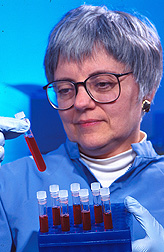This page has been archived and is being provided for reference purposes only. The page is no longer being updated, and therefore, links on the page may be invalid.
| Read: additional article in Agricultural Research |
Soy Soothes the Circuits in Body CellsBy Judy McBrideFebruary 14, 2000 Human body cells are constantly barraged with chemical signals that pester them to respond. Miraculously, they do a pretty good job of filtering out the “noise” and staying focused on their purpose. But some cells lose the ability to regulate these signals, and they react before they should. Researchers now believe this loss contributes to chronic diseases, such as cancer and heart disease. Foods play an important role in filtering out this chemical noise. Test tube studies more than a decade ago show that a phytonutrient in soy foods--genistein--dampens communication from the cell’s surface to its interior. Now, an Agricultural Research Service study gives the first evidence of this dampening effect in an animal. For four weeks, chemist Norberta Schoene, based at the ARS Nutrient Requirements and Functions Laboratory in Beltsville, Md., fed young rats diets containing soy protein with high or low levels of genistein. Then she measured how the animals’ blood platelets responded. Platelets are quite sensitive to outside signals and so are a good model for studying cell signaling. In three different tests, the platelets from the animals receiving the high-genistein diet showed less response to such signals. Schoene’s hypothesis: Isoflavones may reduce over-responsive signaling that produces chronic disease. For example, if an order to divide gets “heard” by too many cells, it could lead to unrestrained growth as in cancer or an overactive immune system. Japanese diets on average contain about 10 times more soy than North American diets, and the Japanese have a lower incidence of cancer and heart disease. The genistein-rich diets in this study had the equivalent of twice the average Japanese genistein intake. The genistein-poor diet contained the equivalent of the U.S. intake of soy. Tofu, tempeh and miso are some soy foods rich in genistein and other isoflavones. An article about this research is in the February issue of Agricultural Research magazine. Scientific contact: Norberta W. Schoene, ARS Nutrient Requirements and Functions Laboratory, Beltsville, Md., phone (301) 504-8388, fax (301) 504-9062, schoene@307.bhnrc.usda.gov. |


